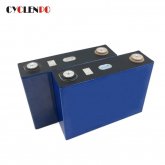Hello DiySolar Members.
LiFePO Cell spec and application verification
Firstly as a total newbie to this forum and for that matter any other forum. I would like to thank the members that helped with my last post. As a result of this I have taken advice and done more research from buying complete batteries to building my own.
The application is for the House Batteries on my boat in Italy since this is also my home. The original was 10 x 12vdc x 230AH wired for 24Vdc output.
My proposed replacement LiFePO solution is
3 x 200AH x 24vdc LiFePO batteries.
After suggestions from forum members I researched supply of suitable cells. I have attached details of specs of the cells and would appreciate advice on suitability.
Based on Mr Prowse’ comments the life time of the cells can be best optimised by a slow current charge rates so I am curious as to whether these units are suitable for long life service.
The boat has dual Victron 3000/24/70 inverter chargers. The old versions about 14 years old but they do have lithium battery configuration options.
Also Mr Prowse hinted that wiring batteries up in Parallel had potential risks in terms of balancing batteries so nothing goes out of balance. With the configuration I was thinking of this comprising 3 x 300 x 24v batteries. My thinking being that if one bank failed I would still have 400AH left on the remaining batteries while getting repairs. But maybe there is a better way to achieve fault tolerance. I noted the including of fuses on the positive terminals but what type of fuse, quick blow, anti surge? Did not get that bit.
Regarding the BMS and the importance to me of longevity of service life. I understood this to mean that if you charged the batteries at a low rate the life time of the batteries would be optimised. How do I convert that into a meaning that is practical. What sort of BMSs should I buy? I was looking at 3 x Daly 8S 24Vdc but I do not know what current load it should be to achieve the optimum charging. The 200AH of the battery or do I need to consider the Victron inverter chargers or what?
I realise that above is the hallmarks of a total beginner but would really appreciate if anyone can give me some practical advice on this.
All the best
Guy
LiFePO Cell spec and application verification
Firstly as a total newbie to this forum and for that matter any other forum. I would like to thank the members that helped with my last post. As a result of this I have taken advice and done more research from buying complete batteries to building my own.
The application is for the House Batteries on my boat in Italy since this is also my home. The original was 10 x 12vdc x 230AH wired for 24Vdc output.
My proposed replacement LiFePO solution is
3 x 200AH x 24vdc LiFePO batteries.
After suggestions from forum members I researched supply of suitable cells. I have attached details of specs of the cells and would appreciate advice on suitability.
Based on Mr Prowse’ comments the life time of the cells can be best optimised by a slow current charge rates so I am curious as to whether these units are suitable for long life service.
The boat has dual Victron 3000/24/70 inverter chargers. The old versions about 14 years old but they do have lithium battery configuration options.
Also Mr Prowse hinted that wiring batteries up in Parallel had potential risks in terms of balancing batteries so nothing goes out of balance. With the configuration I was thinking of this comprising 3 x 300 x 24v batteries. My thinking being that if one bank failed I would still have 400AH left on the remaining batteries while getting repairs. But maybe there is a better way to achieve fault tolerance. I noted the including of fuses on the positive terminals but what type of fuse, quick blow, anti surge? Did not get that bit.
Regarding the BMS and the importance to me of longevity of service life. I understood this to mean that if you charged the batteries at a low rate the life time of the batteries would be optimised. How do I convert that into a meaning that is practical. What sort of BMSs should I buy? I was looking at 3 x Daly 8S 24Vdc but I do not know what current load it should be to achieve the optimum charging. The 200AH of the battery or do I need to consider the Victron inverter chargers or what?
I realise that above is the hallmarks of a total beginner but would really appreciate if anyone can give me some practical advice on this.
All the best
Guy



